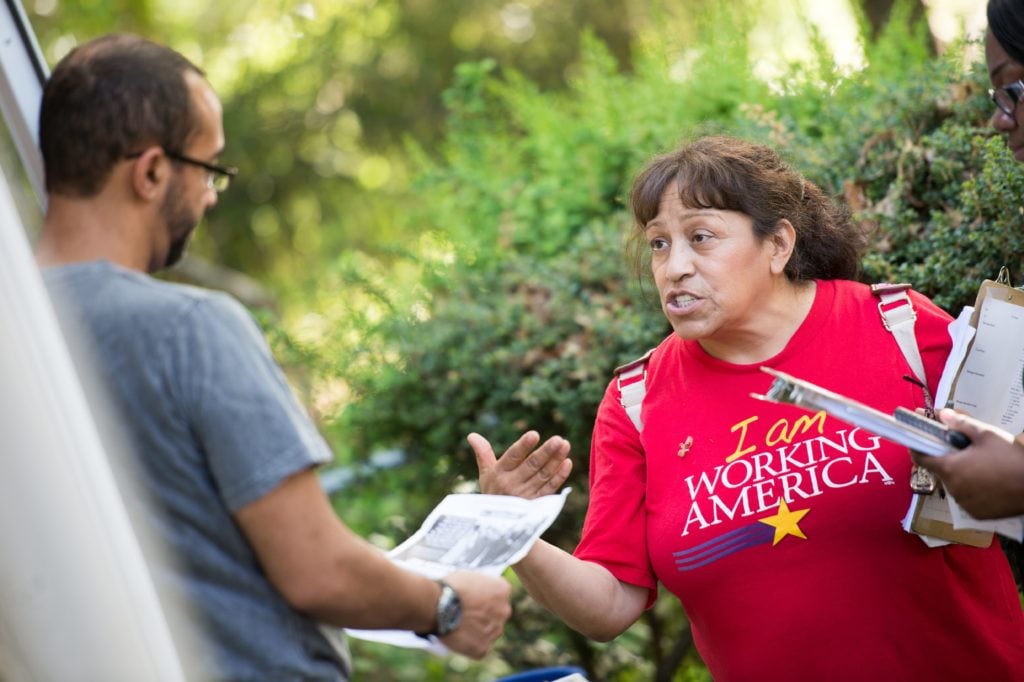Television ads smearing an opponent. Flyers that fill your mailbox. Social media messages that clog your online life. Sounds like a typical election year.
In the 2016 election, $4.6 billion – that’s right, billion – was spent on messaging and media and only $160 million on organizing. That means the investment in talking with people was only 3.5% of what was spent talking at people, according to the Federal Election Commission.
No wonder people say that politicians don’t care about what they think.
What if we treated politics more like union organizing? Real conversations with people based on their issues and giving people opportunities to be active, to be part of the solution. We have that opportunity as we go into the 2020 elections when millions of dollars will flood politics and thousands of people will knock on doors.
Canvassing as organizing
Canvassing as organizing has been our approach at Working America since 2003, when we started going door to door in working class communities. Affiliated with the AFL-CIO, we reach out to people who don’t have a union on the job. We engage people who aren’t looking for us.
Ninety percent of our 3.5 million members aren’t in other progressive organizations. We organize year-round, and even when we are working on an election we lead with issues, not candidates. We connect people to collective power and we track every conversation.
What does that look like, and what can it mean for 2020?
“All of our conversations start with, ‘what is most important to you?’ That is not a question a TV can ask you, that’s not a question a radio can ask you, it’s a question a person can ask you,” explained Angel Darcourt, a Working America field director. “And that’s what makes this such a great movement to be part of.”
Working America canvassers don’t deliver a rap or drop lit. They engage people who are despairing, confused or angry at being dismissed. With Fox News usually on TV on the other side of the screen door, we may not agree with their first take on things, but we’re not there to tell them they are wrong – we’re there to tell them something they don’t know.
Gertrude in Columbus, for example, was a strong Trump supporter. But when we told her and her middle-aged daughter that Trump’s policies would cut back on the heating assistance program, they were shaken. “We depend on that,” her daughter said as she slumped in her chair.
We help people identify the real source of problems. People often don’t know who to blame, blame themselves or blame the victim for seemingly intractable problems.
Paula is a middle-aged health care administrator in Columbus who chides young people for not working hard enough and being willing to start at the bottom. But when we talked more about who benefits when the only jobs available are low-wage, she shifted her focus. “People are working two jobs. It’s tough to make ends meet. No one pays enough – companies could pay more, my hospital could pay more.”
Others blame immigrants for taking jobs or using public resources. These aren’t easy prejudices to address but our canvass leaders described strategies they use. They expand the conversation to broader economic issues and make it an “us” fight. They call for corporate accountability on workers’ rights so a vulnerable part of the workforce can’t be used to bring down wages for everyone.
Many of our organizers in white working class neighborhoods are people of color, and they bring their own experiences to the conversation.
“I tell them, ‘I’m a daughter of an immigrant and was a welfare kid,’” Angel explains. These respectful interactions between strangers across race can make a connection that people at the door may not have in other parts of their lives.
Opportunity for collective action on the spot
We promote collective power and accountability. After decades of declining living standards for working families, many people blame politicians for failing to deliver.
As part of a series of in-depth conversations we call “Front Porch Focus Groups”, we surveyed 1,200 Black, white and Latinx voters in person in 2017. Two out of three people we talked to, across race, named politicians as the source of problems in the economy. Meanwhile, Wall Street and big corporations hide in plain sight while people focus on dysfunctional politics.
As a result, voters are attracted to right wing populists or don’t vote at all. But when we explain that the problem is big banks and corporate lobbyists have too much influence in our economy and politics, people respond to the call to band together for strength in numbers. We create the opportunity for collective action on the spot, asking new members to sign a petition, write a letter to their congressperson or call their state representative.
We keep track of people and get back to them. Robert says education is his most important issue, he has two little kids, he works at a WalMart. He distrusts politicians and he signed the petition to expand Medicaid. We know that and more about the millions of people we’ve talked with.
We’ll get back to Robert throughout the year on social media, and will be back in his neighborhood. When it’s time to vote we’ll let him know where the candidates stand on his issues. Even though Robert gets his information from conservative cable TV, he’ll take our information into account. Robert doesn’t pay dues to Working America but our studies show that a first contact at the door followed by other information has an impact that lasts up to four years.
Membership matters. Two out of three people we talk to sign up as members and half of them opt in to our digital program. The act of becoming a member and signing up to hear from us makes a difference we can measure. In 2018, 8 percent of Trump voters voted for a Democrat for Congress, but 38 percent of Trump voters who were Working America members voted for a congressional Democrat. And Working America members are 3 to 5 times more likely to be persuaded by our communication compared to the general public. In 2018, the cost per vote in our digital campaign among members was only $13.
Do the math. When I started organizing in the 1970s, we tracked workers in union organizing campaigns on index cards for the same reason we use sophisticated data collection and analysis now – we’re spending members’ dues on campaigns and need to hold ourselves accountable.
Working America has run 140 clinical tests of our work to evaluate and improve our targeting, communication methods and outcomes. Going in to 2020, we can identify exactly who we need to talk to over the next year and where they are concentrated geographically. “There’s the movement and there’s math,” according to Matt Morrison, Working America executive director. “Our organizers are out there every night speaking from the heart, and we are making sure it counts by analyzing what works so that the conversations lead to wins.”
What could 2020 look like?
Let’s look at Pennsylvania. Working America projects there will be 6.2 million votes in the state. We identified 2.5 million voters who are persuadable, of which 365,000 are current Working America members. If we organize an additional 456,000 members, and then just canvass those 600,000 persuadable members, we will end the year with more than 1 million conversations, 131,000 extra Democratic voters, and 230,000 new digital subscribers we can engage and educate beyond the election.
After the elections, members will push for the policies we need, hold politicians accountable and help restore the practice of and faith in democracy. We will also know what those 600,000 members care about and what kind of jobs they do, so local labor unions can have a pool of responsive workers with whom to do traditional and innovative organizing.
And we can do more. Working with partner unions we can identify union members in those targeted districts and hit their doors too. We will amplify the message they are getting from their unions, sign them up as contributors to their union’s political action fund, and in some cases, reaffirm their membership in their public sector unions and move them to direct dues payments. By identifying exactly who we want to talk with in specific neighborhoods we can bring swing voters to our side, encourage drop off voters, gain union members and build union political power at the same time.
Unions have strengthened their outreach to members, deepened their political work, and funded canvassing that reaches out to the general public. Often, the union campaigns are the best in an election. We can amplify those strengths and take organizing and politics out of the silos they have been in for too long.
Don’t wait until Labor Day to begin political campaigning. Start now so we can make politics look more like organizing. We can make a reality of the AFL-CIO political slogan from the 1990s: building to win and building to last.

